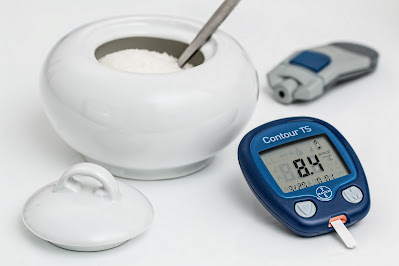Insulin sensitivity refers to the ability of the body's cells to respond to insulin and utilize glucose from the blood for energy. When the body becomes insulin resistant, it means that the cells are not responding to insulin properly, leading to elevated blood sugar levels, which can contribute to various health problems, including diabetes and cardiovascular disease.
Here are the top 10 spices that promote insulin sensitivity:
Cinnamon: Studies have shown that cinnamon can improve insulin sensitivity by increasing glucose uptake in the cells.
Turmeric: Curcumin, the active ingredient in turmeric, has been shown to improve insulin sensitivity and reduce inflammation.
Fenugreek: This spice contains compounds that can improve insulin sensitivity and reduce blood sugar levels.
Ginger: Ginger has been shown to improve insulin sensitivity and reduce inflammation in the body.
Garlic: Garlic can improve insulin sensitivity and reduce blood sugar levels by increasing insulin secretion.
Black pepper: Piperine, the active ingredient in black pepper, can improve insulin sensitivity and reduce inflammation.
Rosemary: This herb contains compounds that can improve insulin sensitivity and reduce inflammation.
Sage: Sage has been shown to improve insulin sensitivity and reduce inflammation in the body.
Cloves: Cloves can improve insulin sensitivity and reduce blood sugar levels by increasing insulin secretion.
Oregano: Oregano contains compounds that can improve insulin sensitivity and reduce inflammation.
It is worth noting that while adding these spices to your diet may help improve insulin sensitivity, it is important to follow a balanced and healthy diet and lifestyle to maintain good health.
Weight Loss Without Starvation - All About Mediterranean Diets, Belly Fat Burning Foods, Healthy Eating Vegan No Carbs Diets To Lose Weight Fast, Lose Belly Fat Fast, Lose Fat Quickly Without Lethargy.
Thursday, April 27, 2023
Top 10 Spices That Promote Insulin Sensitivity
Monday, April 17, 2023
How Does Insulin Sensitivity Effect Weight Loss
Insulin sensitivity refers to the body's ability to respond to insulin, a hormone that helps regulate blood sugar levels. When insulin sensitivity is high, the body is able to use insulin effectively to transport glucose (sugar) from the bloodstream into the cells, where it can be used for energy.
On the other hand, when insulin sensitivity is low, the body's cells become resistant to insulin, meaning that they don't respond as well to the hormone. This can lead to high blood sugar levels, as the glucose remains in the bloodstream rather than being transported into the cells.
Insulin sensitivity can have an impact on weight and fat loss because insulin is involved in the regulation of fat storage and metabolism. When insulin levels are high, the body is in a "storage" mode, meaning that it is more likely to store excess glucose as fat rather than burning it for energy. Additionally, insulin resistance is often associated with increased levels of inflammation, which can make it more difficult to lose weight and burn fat.
Improving insulin sensitivity can be helpful for weight and fat loss. This can be achieved through a healthy diet, regular exercise, and adequate sleep. Eating a balanced diet that is low in refined carbohydrates and high in fiber can help to regulate blood sugar levels and improve insulin sensitivity. Engaging in regular physical activity can also help to improve insulin sensitivity, as exercise increases the body's ability to use glucose for energy. Finally, getting enough sleep is important for regulating hormones, including insulin, and improving overall health.
Sunday, April 9, 2023
Is Red Light Therapy Effective For Weight Loss
Red light therapy, also known as low-level laser therapy (LLLT), is a non-invasive procedure that uses red and near-infrared light to improve various health conditions. Recently, there has been growing interest in using red light therapy for weight loss. In this article, we will examine the evidence behind this claim.
First, let's understand how red light therapy works. Red light therapy devices emit low-level wavelengths of red and near-infrared light that penetrate the skin and are absorbed by the cells. This stimulates the production of energy in the cells and enhances cellular function. It is believed that this increased cellular activity may lead to weight loss by boosting metabolism and reducing fat storage.
So, can red light therapy help with weight loss? Some studies suggest that it may be effective. For example, a study published in the Journal of Obesity found that women who received red light therapy three times per week for four weeks experienced a significant reduction in waist circumference, hip circumference, and body fat percentage compared to those who received a placebo treatment. Another study published in the journal Lasers in Medical Science found that overweight and obese adults who received red light therapy twice per week for four weeks had a significant reduction in waist circumference and body fat percentage compared to those who received a placebo treatment.
One theory behind how red light therapy may aid in weight loss is through its effect on adipocytes, or fat cells. Red light therapy is believed to stimulate the release of fat from the adipocytes, which can then be used by the body for energy. Additionally, red light therapy may enhance blood flow and oxygenation in the treated area, which can also contribute to weight loss.
It is important to note that red light therapy is not a substitute for a healthy lifestyle. While it may aid in weight loss, it should be used in conjunction with a balanced diet and regular exercise. Additionally, the results of red light therapy may vary depending on the individual and the severity of their weight issues.
There are also some potential side effects of red light therapy, although they are rare. These may include skin irritation, redness, or burns. It is important to use a high-quality red light therapy device and follow the manufacturer's instructions carefully to minimize the risk of side effects.
In conclusion, while more research is needed to determine the effectiveness of red light therapy for weight loss, some studies suggest that it may be a promising treatment option. Red light therapy should be viewed as part of a comprehensive weight loss plan that includes healthy eating and exercise habits. As with any new treatment, it is important to speak with a healthcare professional before starting red light therapy to ensure that it is safe and appropriate for your individual needs.
You may find this new weight loss regime worth trying out.....
Sunday, April 2, 2023
3 Popular Fat Loss Diet Plans That Really Work
Here are 3 Popular Fat Loss Diet Plans That Actually Work
Ketogenic Diet
The Ketogenic Diet is a high-fat, low-carbohydrate diet plan that forces the body into a state of ketosis, where it burns stored fat for energy instead of carbohydrates. Some of the pros of this diet include a significant reduction in appetite, rapid weight loss, and improved blood sugar levels. However, some cons of this diet include a potential lack of important nutrients, the risk of developing the "keto flu" during the transition phase, and the difficulty of maintaining the strict macro-nutrient ratios required for the diet.
Mediterranean Diet
The Mediterranean Diet is a plant-based diet that emphasizes whole foods, lean proteins, and healthy fats, such as olive oil and nuts. Some of the pros of this diet include a reduction in inflammation, improved heart health, and sustainable weight loss. However, some cons of this diet include the potential for high calorie intake if not closely monitored, the need for careful meal planning and preparation, and a potential lack of variety in some regions where certain foods may not be readily available.
Intermittent Fasting
Intermittent Fasting is not a specific diet plan, but rather an eating pattern that involves alternating periods of fasting and eating. Some of the pros of this eating pattern include improved insulin sensitivity, reduced inflammation, and effective weight loss. However, some cons of this pattern include the potential for increased hunger and food cravings during fasting periods, the need for careful monitoring of nutrient intake during eating periods, and the potential for negative effects on some people's mental health and well-being due to the strict adherence required.
Ultimately, the success of any diet plan depends on an individual's unique needs and preferences, and it is important to consult with a healthcare professional before starting any new diet plan.



